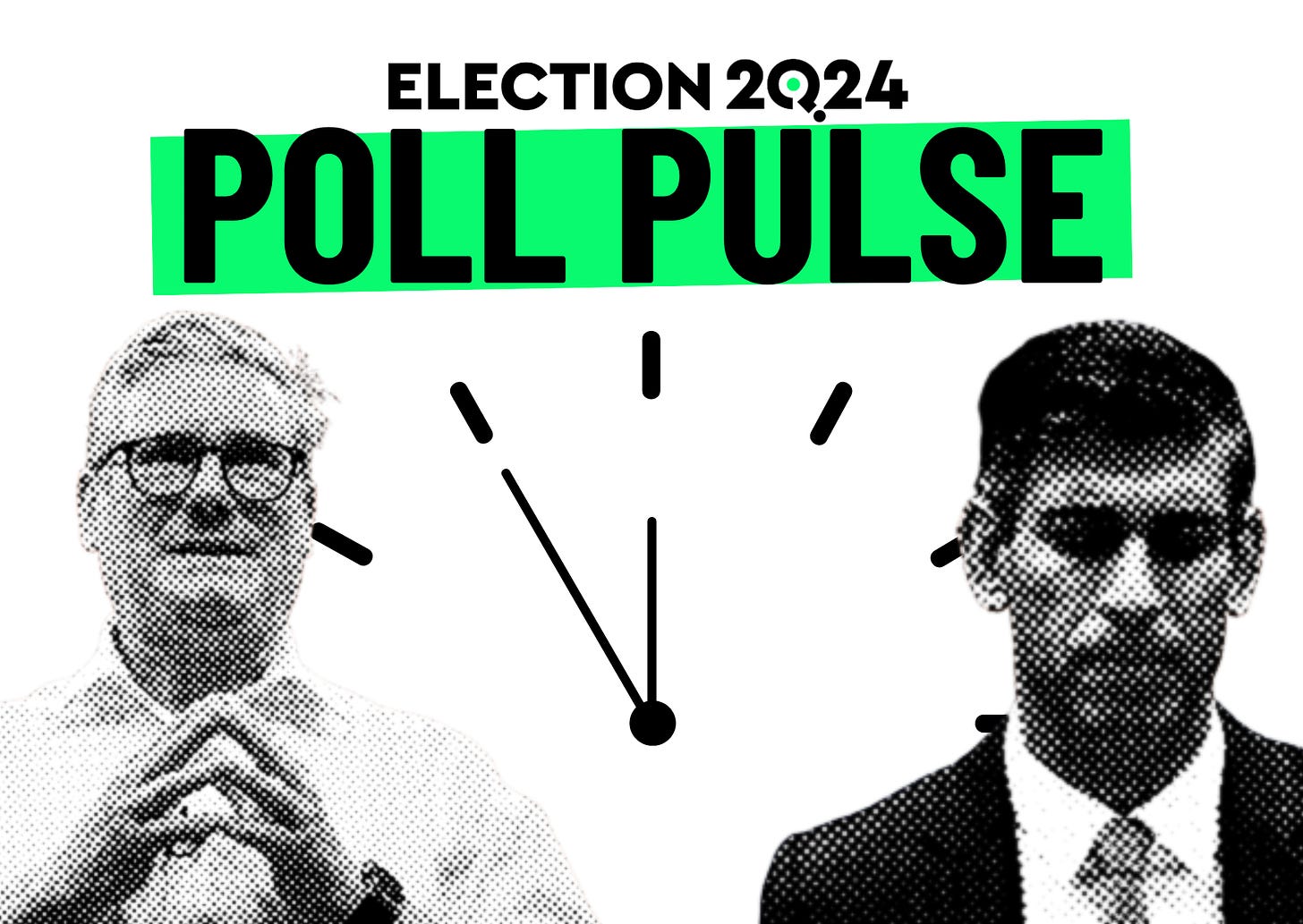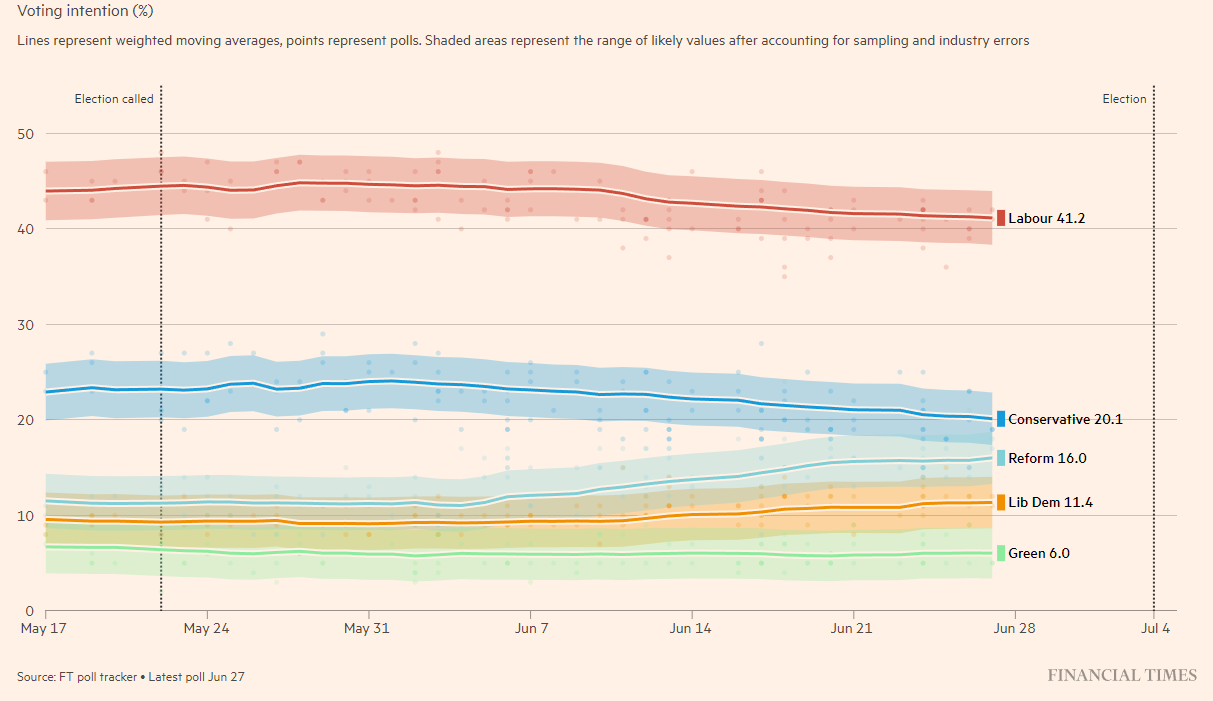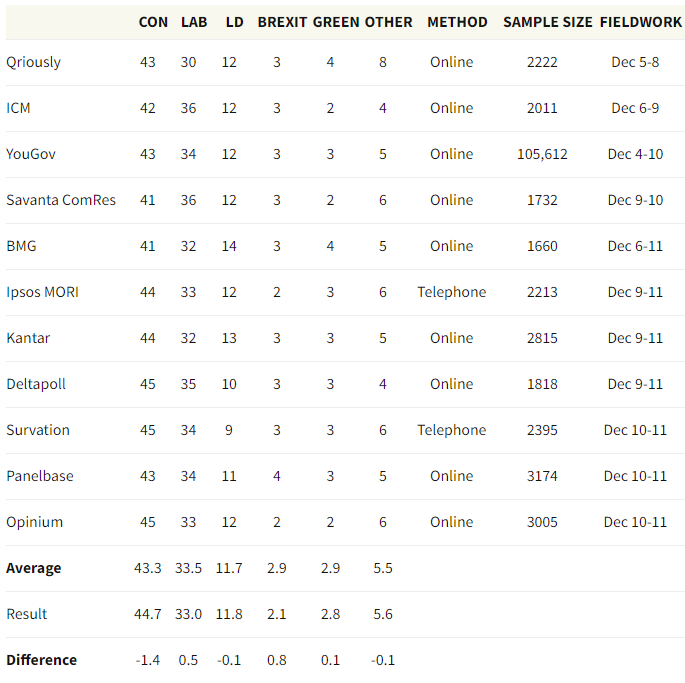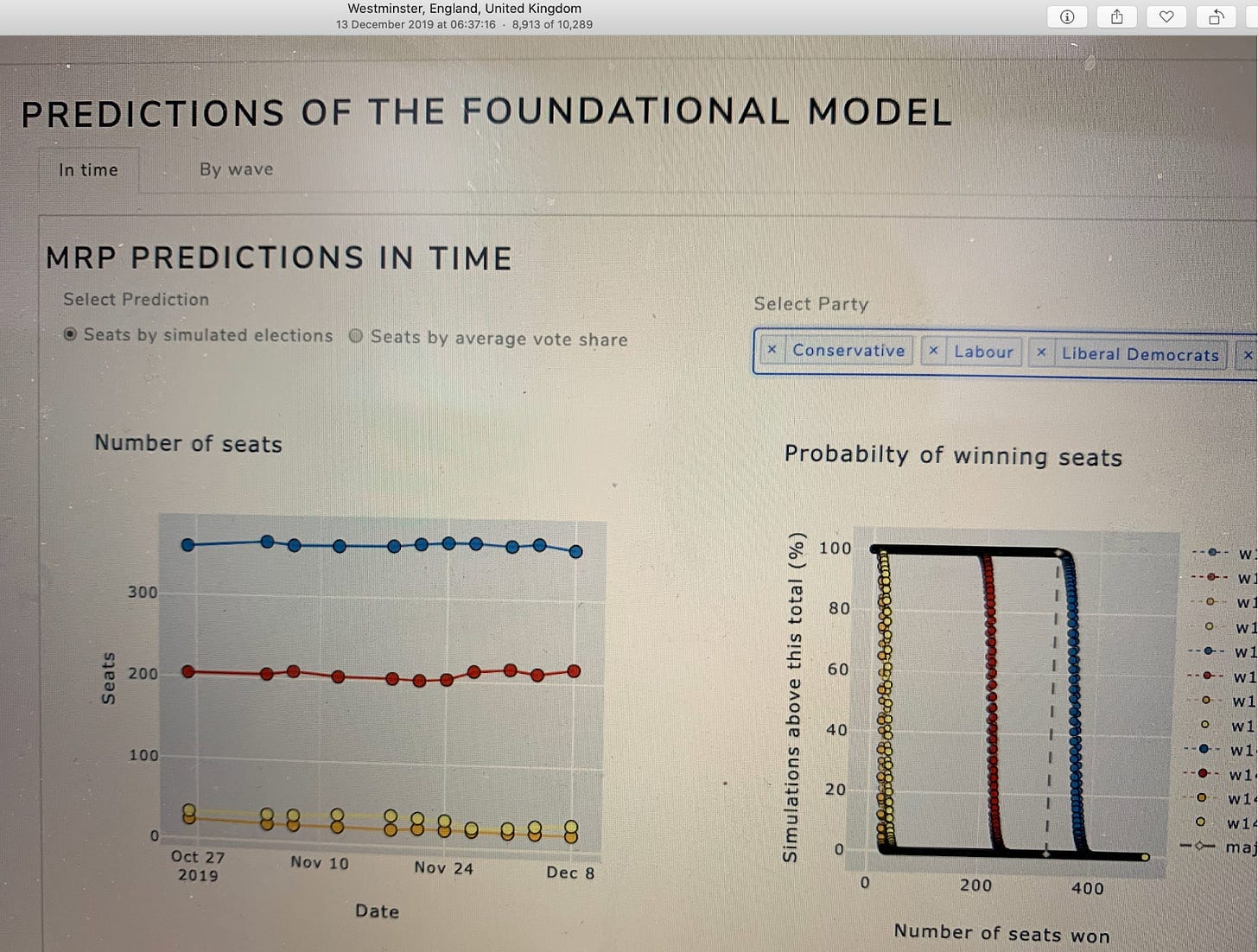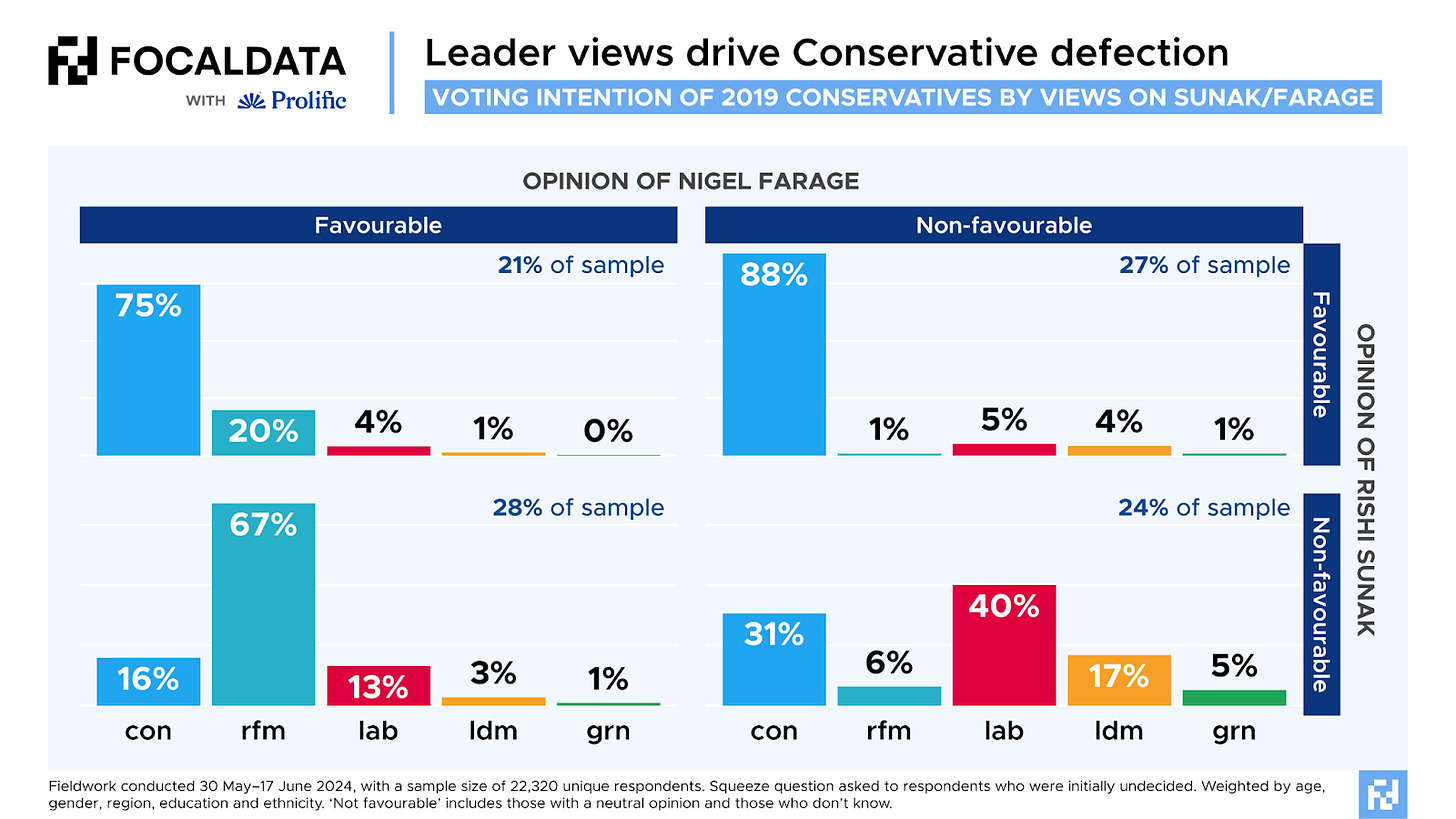Poll Pulse #4: A Momentous Pause
A weekly series focusing on the data and polls of the election
If you have enjoyed the reading The Political Inquiry we would appreciate anything you can give back with a free or paid subscription. All donations received will be put back into the Substack to continue its development. Thank you to those who have already subscribed and donated.
We are just six days away from the general election and the polls are, well, very boring – almost all are showing a 20-point lead for Labour, while the aggregators and MRPs remain stable in their headline projections.
With that in mind, the following piece contains some thoughts on how 2024 compares to previous elections, the ceiling of the Reform vote and a summary of where my favoured polls are at one week out.
They Want ‘17 but got ‘19!
It should be evident to most that this is no 2017 election; there will be no Corbyn-style comeback for the Conservatives, and even if there was a major polling error Labour’s majority would still be in the triple figures. If anything, this seems like 2019 in terms of polling and stability. In 2019 the margin of polling error was low, with most polls getting it almost bang on. Considering the amount of realigning votes in the volatile post-2016 electoral marketplace (and failures of the pollsters in 2015/17 elections), 2019 was an impressive performance by the polling industry:
The only real notable error was a slight undercooking of the Tory vote, however the three gold standard pollsters (in my mind) of Opinium, Survation and Ipsos all pretty much nailed it. The fact that all three of these have almost converged in the 2024 polls (even when using different methods) should turn heads: there is to be no shock. Returning to our 2019 comparison, it's important to remember that during the campaign both external polling and internal campaign models all showed an extremely stable picture. Then chief advisor to the PM Dominic Cummings’ thoughts on the last few days of 2019 campaign are quite illuminating:
Despite having read Tetlock on the dangers of substituting one’s own judgement for the model, on election day I substituted my own judgement for the model. Just before 2200 when the PM asked me what I thought I said ‘359’. (On the sweepstake board in the office I also wrote ‘335-370 80% confidence’ which shows how I pulled my estimate low.)
As you can see from this snapshot of our dashboard (taken at 630am on 13th as the PM wrote his victory speech), the MRP had been very stable — i.e ‘reality’ was much more stable than you might think watching the daily news and polls. It’s also interesting that the model thought the probability of a hung Parliament was much less likely (near 0%) than it ‘felt’ to the pundits or me. Though I’m often critical of pundits, my brain worked like theirs on this even though we told ourselves ‘we’re thinking like pundits by expecting the same thing to happen this time as last time’, i.e that the Tories would do worse than polls predicted.
This is something everyone addicted to politics is guilty of: overthinking the smaller probability outcomes because it might happen, but not because it is statistically likely. In essence, our takes are not always weighted in reality. I think this mindset, which even Cummings succumbed to, was fuelled by the electoral shocks of the 2016 Referendum and 2017 election, and to a lesser extent 2019 European elections when the Brexit Party won after only existing for 45 days. For a British political system that is designed to reduce insurgents, the extremely volatile results of these years have had a lasting effect on us; they practically rewired even the hardest realists or intelligent political strategists to think ‘everything is possible’. Even if research shows that 21st century voters are more volatile this does not mean they switch dramatically within an election period. What 2019 demonstrated, and likely 2024 too, is that sometimes not much happens. The iron rule of inevitable poll-tightening in elections has certainly melted away. As
stated ‘Sometimes pundits invoke iron laws that, on examination, turn out to be rubber.’The other factor to consider about 2017 and 2019 is that they were likely the peak of two-party voting – with the highest Lab-Tory combined vote since 1974. But the Conservatives have achieved over 40% just twice in 25 years, which is unprecedented. The mix of Brexit and Corbyn were the key stimulants in these ‘17 and ‘19 Tory votes – which for the party have proved ephemeral at best, and actively misleading at worst. My point is that the level of calm we’re seeing in the headline result and amount of digits of the Labour majority is significant, but could be masking churn underneath. There is possibly a larger right-realignment about to occur – the last time the right were split was 2015 but as you can see the Tory vote remained at 38%. This time it could be more fundamental, but for now it only remains a possibility.
Reform Pause = Tory Rally?
As Dylan Cridland pointed out previously in this series, we have seen pollsters divided into two camps over this election: the nowcasts which remove those who answer ‘don’t know’, and the forecasts which attempt to (sometimes aggressively) reallocate ‘don’t knows’ based on who they will most likely vote for. In some polls (such as Opinium) there has been a degree of convergence between the two models, but the most bullish forecaster, run by ex-No.10 pollster James Johnson, JL Partners, remains the outlier. Their latest poll shows the lowest Labour lead (16%) has the Tories on the highest their vote share: 25%. Intriguingly, their Reform surge has reversed, with a return to 15%.
What's interesting is that JL are pushing their methodology into the last week, essentially trying to predict what voters might do as they walk into the ballot box. The big question this tackles, which I'm not sure a poll can accurately answer, is the conundrum I posed in a previous piece:
Many torn between the Tories and Reform could flit between the two over the last few weeks, with their final decision made in the final days or hours. [...] I think it will be really hard for many traditional Conservatives, not just in the south, to pull the lever which could permanently kill the party they have voted for their entire life.
Either James Johnson’s team are accurately predicting this volatility which will run up until election night, or they are reflecting an actual pause in Reform’s momentum – possibly because of Farage’s controversial comments made about Ukraine and a deplorable Reform candidate wanting immigrants shot. We are likely seeing a ceiling to Reform’s vote that Farage’s belligerent tone will only reinforce, as FocalData’s breakdown of the vote illustrates:
The bottom left quadrant is where the core of Reform’s vote is coming from. And while this is marginally the biggest part of the base, they have only another 16% to squeeze. Intriguingly, 13% are actually switching to Labour. The top left quadrant (2019 Tories who like Sunak and Farage) is the only real area which Farage could improve in, and attacking the Tories record with controversial claims is certainly not the way to do that. If we were seeing a realignment of the right, I’d want to see more splits in that top left of people saying ‘I’m a natural Conservative and I like what Sunak has done to repair the economy (and likely Johnson previously), but I also like Farage and his policies and think his alternative vision could be better for the country’.
The only change we’ve seen in the campaign is the possibility of Reform becoming an actual alternative right-wing party. However, the niche attack strategy matched with lack of presence and time in parliament, party infrastructure, and with little chance of winning even two seats, means the offer of becoming a wider right-wing force is obviously sinking with those Tory voters that are favourable of Farage. For me, this is the Reform stall. Without momentum – which is key for insurgent parties – it could be over for Reform’s hope of supplanting the Tories (in vote share) this election, if it was ever realistic in the first place.
Same Old Gold:
Ipsos:
LAB: 42% (-1)
CON: 19% (-4)
RFM: 15% (+6)
LDM: 11% (+3)
GRN: 7% (-2)
SNP: 5% (=)
(21-24 Jun. Changes w/ 31 May - 4 Jun)
Survation:
LAB: 41% (=)
CON: 18% (-2)
RFM: 14% (-1)
LDM: 12% (=)
GRN: 5% (-1)
SNP: 2% (=)
(21-25 Jun. Changes w/ 14-18 Jun)
Opinium
LAB: 40% (=)
CON: 20% (-3)
RFM: 16% (+2)
LDM: 12% (=)
GRN: 9% (+2)
SNP: 2% (=)
(19-21 Jun. Changes w/ 12-14 Jun)
As my three golden pollsters, in terms of past success and methodology, converge it's safe to say a large Conservative rally is unlikely – but so is a complete collapse of their vote below Reform. A momentous pause has occurred, and I can't see much more movement in either direction. Ipsos, while showing the lowest government ratings since the end of the last consensus in 1979, has only reinforced the difficulties Reform are facing (the 10-point swing still not enough to overtake the Tories).
The only real disagreement between the higher quality polls is the scale of the Green vote – though this is unlikely to have a large impact on the result. The fact that the more radical (forecast) pollsters are a full 6-7 points off the Tory totals supposes they are about to get it quite wrong – or that there will be a notable shift to the Tories over the next week. With the betting scandal rumbling on, this is unlikely, even if Sunak’s Reform attacks could trigger a small consolidation. Overall, there has been little change in the likelihood of the headline result. It is the echoes of 2019, and not 1992 or 2017, which diffuse into 2024.
Tom Egerton is a political writer and researcher, his new book The Conservative Effect, co-edited with Anthony Seldon and published by Cambridge is OUT NOW, you can order it here: with Cambridge, Waterstones or Amazon. Follow Tom on X / Twitter here.





